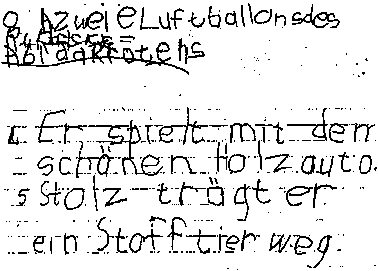
Hello Susan
My 9-year-old son has dysgraphia (at least the handwriting part). He shows all the symptoms: he is highly intelligent, yet his writing is illegible; he mixes upper and lowercase letters, and his letter sizes and shapes are inconsistent. His pencil grip is poor — he uses wrist movements to write instead of finger movements.
We recently had a parents’ evening, and his teacher said he is very bright when it comes to answering questions, and she would expect him to be an A student. But when it comes to putting information on paper, he is likely to get a D.
He has done OT for two years and remedial for one. I am really at a loss as to where to go for help and support and what to do next. I believe every child has the right to reach their full potential, and my fear is that he will switch off and no longer try unless we help him. Any advice you could give me would be greatly appreciated.
Liu
.
.
Dear Liu
You are entirely right: every child deserves to reach their full potential. And we, as educators, are responsible for ensuring they receive the necessary opportunities to reach their full potential — sooner rather than later.
Having dysgraphia can be compared to having writer’s block: Think back to when you had to write an essay for school but experienced crippling writer’s block. It might have lasted for a couple of hours or even days, but in the end, you probably hit that moment of inspiration when the ideas started flowing.
Now, imagine reaching that point but having no ability to write down your ideas. This is how individuals with dysgraphia feel.
It’s a problem that cannot be ignored because even in these days of the magic of computer word processing, writing is a necessary competency. It is the usual medium through which students convey to teachers what they have learned. Adults also find writing a necessity they cannot avoid in many situations.
What causes dysgraphia in handwriting?
We all know that most problems can only be solved if one knows what causes the problem.
We should always remember that human learning is a stratified process when teaching. This implies that specific skills have to be mastered first, before it becomes possible to master subsequent skills. One has to learn to count before it becomes possible to learn to add and subtract. In the same way, there are skills that a child must have mastered first, before they will be proficient in handwriting. The child’s handwriting will not improve unless underlying shortcomings are addressed first.
In her book Learning Disabilities: Theories, Diagnosis, and Teaching Strategies, Janet Lerner states that some of the underlying shortcomings that interfere with handwriting performance are
- Faulty visual perception of letters and words
- Difficulty in retaining visual impressions
- Poor motor skills.
.
The child’s problem may also be in cross-modal transfer from the visual to motor modalities.
Help for dysgraphia in handwriting
The image below links to a comprehensive handwriting curriculum for dysgraphia. It consists of exercises to automatize visual perception and enhance visual memory, motor skills, and sensory-motor integration:
Hard work pays off! The handwriting below belonged to an eight-year-old German boy with dysgraphia. His parents started with very intensive Edublox training in April. The second sample was taken from his schoolwork three months later.

How to improve poor pencil grip
A good way of teaching correct pencil grip is to play darts with a child. However, using the rubber pencil grip aid together would not be a good idea because holding the pencil will feel quite different from holding the dart.
Play darts with your child for about 5 to 10 minutes every day. It should help solve the problem.
Regards,
Susan
.
Tips for sending questions
Send your questions to [email protected].
Try to give as much detail as possible when sending your questions. Include your child’s age and grade and the specific problems you have noticed that concern you.
Sign your letter to Susan with your first name only, or a pseudonym if you prefer. Your identity remains private, and we will not publish your contact details.
More about Susan
Susan is an educational specialist in learning problems and dyslexia and has a B.A. Honors in Psychology and B.D. degree. Early in her professional career, Susan was instrumental in training over 3,000 teachers and tutors, providing them with the foundational and practical understanding to facilitate cognitive development among children who struggle to read and write. With over 30 years of research to her name, Susan conceptualized the Edublox teaching and learning methods that have helped thousands of children who were struggling to read, learn and achieve. In 2007, Susan opened the first Edublox reading and learning clinic, and now there are 40 Edublox clinics internationally. Her proudest moments are when she sees a child who had severe learning difficulties come top of their class after one or two years at Edublox. Susan always takes time to collect the ‘hero’ stories of students whose self-esteem is lifted as their marks improve.
